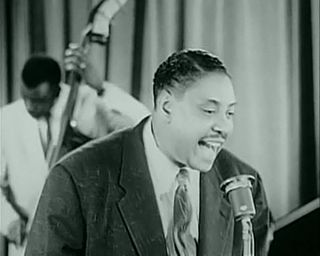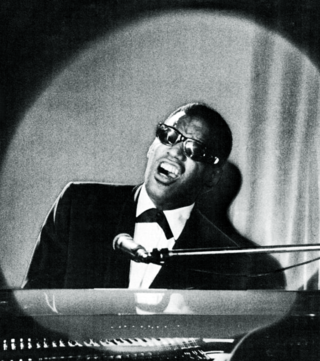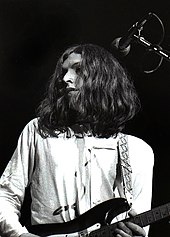
Rhythm and blues, frequently abbreviated as R&B or R'n'B, is a genre of popular music that originated within African-American communities in the 1940s. The term was originally used by record companies to describe recordings marketed predominantly to African Americans, at a time when "rocking, jazz based music ... [with a] heavy, insistent beat" was becoming more popular. In the commercial rhythm and blues music typical of the 1950s through the 1970s, the bands usually consisted of a piano, one or two guitars, bass, drums, one or more saxophones, and sometimes background vocalists. R&B lyrical themes often encapsulate the African-American history and experience of pain and the quest for freedom and joy, as well as triumphs and failures in terms of societal racism, oppression, relationships, economics, and aspirations.

Soul music is a popular music genre that originated in the African American community throughout the United States in the late 1950s and early 1960s. It has its roots in African-American gospel music and rhythm and blues. Soul music became popular for dancing and listening, where U.S. record labels such as Motown, Atlantic and Stax were influential during the Civil Rights Movement. Soul also became popular around the world, directly influencing rock music and the music of Africa. It also had a resurgence in the mid-to late 1990s with the subgenre neo-soul, which added modern production elements and influence from hip-hop.

Booker T. & the M.G.'s were an American instrumental R&B/funk band that was influential in shaping the sound of Southern soul and Memphis soul. The original members of the group were Booker T. Jones, Steve Cropper (guitar), Lewie Steinberg (bass), and Al Jackson Jr. (drums). In the 1960s, as members of the Mar-Keys, the rotating slate of musicians that served as the house band of Stax Records, they played on hundreds of recordings by artists including Wilson Pickett, Otis Redding, Bill Withers, Sam & Dave, Carla Thomas, Rufus Thomas, Johnnie Taylor and Albert King. They also released instrumental records under their own name, including the 1962 hit single "Green Onions". As originators of the unique Stax sound, the group was one of the most prolific, respected, and imitated of its era.

Sam & Dave were an American soul and R&B duo who performed together from 1961 until 1981. The tenor (higher) voice was Sam Moore and the baritone/tenor (lower) voice was Dave Prater (1937–1988).
Stax Records is an American record company, originally based in Memphis, Tennessee. Founded in 1957 as Satellite Records, the label changed its name to Stax Records in 1961. It also shared its operations with sister label Volt Records.

Rufus C. Thomas, Jr. was an American rhythm-and-blues, funk, soul and blues singer, songwriter, dancer, DJ and comic entertainer from Memphis, Tennessee. He recorded for several labels, including Chess Records and Sun Records in the 1950s, before becoming established in the 1960s and 1970s at Stax Records. His dance records, including "Walking the Dog" (1963), "Do the Funky Chicken" (1969), and "(Do the) Push and Pull" (1970), were some of his most successful songs. According to the Mississippi Blues Commission, "Rufus Thomas embodied the spirit of Memphis music perhaps more than any other artist, and from the early 1940s until his death . . . occupied many important roles in the local scene."
Memphis soul, also known as the Memphis sound, is the most prominent strain of Southern soul. It is a shimmering, sultry style produced in the 1960s and 1970s at Stax Records and Hi Records in Memphis, Tennessee, featuring melodic unison horn lines, organ, guitar, bass, and a driving beat on the drums.

Carla Venita Thomas is an American singer, who is often referred to as the Queen of Memphis Soul. She is best known for her 1960s recordings for Atlantic and Stax including the hits "Gee Whiz " (1960), "B-A-B-Y" (1966) and "Tramp" (1967), a duet with Otis Redding. She is the daughter of Rufus Thomas.

A session musician is a musician that is hired to perform in a recording session or a live performance. The term sideman is also used in the case of live performances, such as accompanying a recording artist on a tour. Session musicians are usually not permanent or official members of a musical ensemble or band.
Southern soul is a type of soul music that emerged from the Southern United States. The music originated from a combination of styles, including blues, country, early R&B, and a strong gospel influence that emanated from the sounds of Southern black churches. Bass guitar, drums, horn section, and gospel roots vocal are important to soul groove. This rhythmic force made it a strong influence in the rise of funk music. The terms "deep soul", "country soul", "downhome soul" and "hard soul" have been used synonymously with "Southern soul".p. 18
Bonny "Mack" Rice, sometimes credited as Sir Mack Rice, was an American songwriter and singer. His best-known composition and biggest hit as a solo performer was "Mustang Sally". He also wrote "Respect Yourself" with Luther Ingram.

Kim Weston is an American soul singer, and Motown alumna. In the 1960s, Weston scored hits with the songs "Love Me All the Way" and "Take Me in Your Arms ", and with her duet with Marvin Gaye, "It Takes Two".

Otis Blue/Otis Redding Sings Soul is the third studio album by American soul singer and songwriter Otis Redding. It was first released on September 15, 1965, as an LP record through the Stax Records subsidiary label Volt.

Eddie Lee Floyd is an American R&B and soul singer and songwriter, best known for his work on the Stax record label in the 1960s and 1970s, including the No. 1 R&B hit song "Knock on Wood".

The Sweet Inspirations are an American R&B girl group mostly known for their work as backup singers on studio recordings for other R&B and rock artists. A founding member of the group was Dionne Warwick, who was later replaced by her aunt, Cissy Houston.

William Bell is an American soul singer and songwriter. As a performer, he is probably best known for his debut single, 1961's "You Don't Miss Your Water"; 1968's top 10 hit in the UK "Private Number", a duet with Judy Clay; and his only US top 40 hit, 1976's "Tryin' to Love Two", which also hit No. 1 on the R&B chart. Upon the death of Otis Redding, Bell released the well-received memorial song "A Tribute to a King".

Samuel David Moore is an American singer who was best known as a member of the soul and R&B duo Sam & Dave from 1961 to 1981. He is a member of the Rock & Roll Hall of Fame, the Grammy Hall of Fame, and the Vocal Group Hall of Fame.

"Turn On Your Love Light" is a rhythm and blues song recorded by Bobby Bland in 1961. It was an important R&B and pop chart hit for Bland and has become one of his most identifiable songs. A variety of artists have recorded it, including the Grateful Dead, who made it part of their concert repertoire.
British soul, Brit soul, or the British soul invasion, is soul music performed by British artists. Soul has been a major influence on British popular music since the 1960s, and American soul was extremely popular among some youth subcultures, such as mods, skinheads, and the Northern soul movement. In the 1970s, soul gained more mainstream popularity in the UK during the disco era.
















